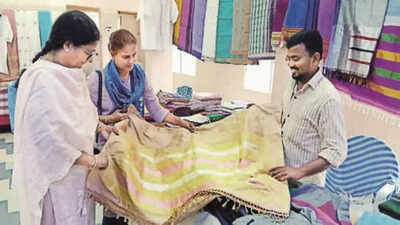Top Searches
- News
- City News
- mangaluru News
- Areca dyes create new hues for Guledgudda, Ilkal saris in Karnataka
Areca dyes create new hues for Guledgudda, Ilkal saris in Karnataka

Ramesh Ayodi displays an areca-dyed Ilkal sari during an exhibition held in Hyderabad
MANGALURU: While experts are trying hard to promote areca syrup (Adike Chogaru), weavers from North Karnataka, under the banner of Guledgudda Khana, have experimented with areca dye that was sent from the coastal Karnataka and Malnad for Guledgudda Khana blouses and Ilkal saris. Eight Ilkal saris, starting at Rs 8,000, are ready and three were presented at an exhibition held in Hyderabad.
Ramesh Ayodi, a weaver with a diploma in textile design who has been working for the revival of Guledgudda Khana said that it was Shree Padre, editor of ‘Adike Patrike’, an agricultural magazine, who introduced adike chogaru and asked if it could be used as a natural dye for Ilkal saris.
“At present, we have experimented on eight Ilkal saris, two khana sarees and 21 metres Guledgudda Khana fabric. While 90% of the natural dye used is areca dye, we have also used an extract or a powder from the rinds of pomegranates and dye produced from manjishta. The response has been good and we have been able to sell three saris at the exhibition ‘Chenetha Santha’ organised by Saraswati Kavula. We have experimented on cotton and silk fabric. However, since areca dye is in liquid form, transporting it is a major challenge,” he said.
Ayodi went on to add that the positive response is encouraging them to take up more experiments.
Shri Padre, the author of ‘Adike Chogaru: Hosa Nireekshegala Chiguru’ a Kannada book on areca syrup, said, “Ramesh has created history by encouraging weavers to use areca syrup, an under-researched and most-neglected resource that is found in abundance in the state.”
“It is a byproduct obtained during the processing of red arecanut,” he added.
“Charaka Women’s Cooperative in Heggodu has been using it as a textile colour in a big way for two decades. Areca syrup has strong potential in the textile industry. However, more research needs to be conducted on the dos and don’ts for farmers and on how to improve and retain the quality of colour pigments.
Areca syrup lends different shades of brown such as pinkish brown. It can be used as an alternative to existing sustainable colours and there is a tremendous potential for its use across the globe. The need of the hour is to encourage artists and weavers to experiment with this. Trials in using sun-dried areca syrup in wooden toys have yielded encouraging results,” he informed.
Ramesh Ayodi, a weaver with a diploma in textile design who has been working for the revival of Guledgudda Khana said that it was Shree Padre, editor of ‘Adike Patrike’, an agricultural magazine, who introduced adike chogaru and asked if it could be used as a natural dye for Ilkal saris.
“At present, we have experimented on eight Ilkal saris, two khana sarees and 21 metres Guledgudda Khana fabric. While 90% of the natural dye used is areca dye, we have also used an extract or a powder from the rinds of pomegranates and dye produced from manjishta. The response has been good and we have been able to sell three saris at the exhibition ‘Chenetha Santha’ organised by Saraswati Kavula. We have experimented on cotton and silk fabric. However, since areca dye is in liquid form, transporting it is a major challenge,” he said.
Ayodi went on to add that the positive response is encouraging them to take up more experiments.
Shri Padre, the author of ‘Adike Chogaru: Hosa Nireekshegala Chiguru’ a Kannada book on areca syrup, said, “Ramesh has created history by encouraging weavers to use areca syrup, an under-researched and most-neglected resource that is found in abundance in the state.”
“It is a byproduct obtained during the processing of red arecanut,” he added.
“Charaka Women’s Cooperative in Heggodu has been using it as a textile colour in a big way for two decades. Areca syrup has strong potential in the textile industry. However, more research needs to be conducted on the dos and don’ts for farmers and on how to improve and retain the quality of colour pigments.
Areca syrup lends different shades of brown such as pinkish brown. It can be used as an alternative to existing sustainable colours and there is a tremendous potential for its use across the globe. The need of the hour is to encourage artists and weavers to experiment with this. Trials in using sun-dried areca syrup in wooden toys have yielded encouraging results,” he informed.

About the Author
Deepthi SanjivDeputy Chief of Bureau at TOI, Mangaluru. Writes on crime, environment, health, politics, education, civic issues, art & culture and human interest stories.
Start a Conversation
FOLLOW US ON SOCIAL MEDIA
FacebookTwitterInstagramKOO APPYOUTUBE









